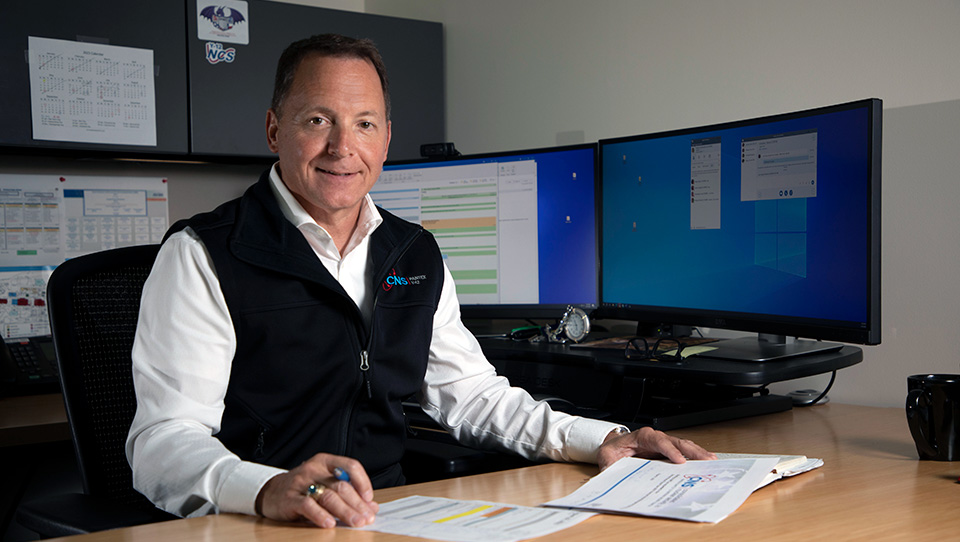I am mission success: Chris Harkins

Take 5 minutes to learn about Chris Harkins, CNS chief operating officer. All views and opinions are the employee’s own and do not necessarily reflect those of CNS.
CNS Chief Operating Officer Chris Harkins helps manage daily operations of Pantex and Y-12 and works with President and Chief Executive Officer Rich Tighe to ensure the sites conduct safe and productive operations. When you consider there are more than 13,000 employees working to achieve the mission, that is a large undertaking.
“I’ve been impressed by the massive scope at Pantex and Y-12,” said Harkins, who arrived at CNS in May. To help keep safety and security at the forefront, he also provides oversight for investigations, critiques, and corrective action plans.
“The similarities between these and other sites made for a seamless transition,” he said. “From the safety first culture to our link to the national security mission, the Pantex and Y-12 workforces have a sense of purpose, are professional and proud, and know what they are doing.”
It doesn’t take new CNS employees long to understand the importance of the Pantex and Y-12 mission and feel a sense of pride and patriotism in serving that mission. For Harkins, a U.S. Navy veteran, the patriotism was already well established, but seeing an assembled product ready for shipment at Pantex recently, he felt added pride.
“Standing next to and seeing the final assembled product [at Pantex] waiting to be shipped to the Department of Defense was surreal,” he said. ”The Pantex workforce is extremely competent, and that is really important in this line of work.”
He has similar thoughts about Y-12. “I’m amazed at the employees’ expertise on uranium and other special materials and how the site is its own self sufficient manufacturing plant.”
The communities around both sites intrigue Harkins, thanks to a childhood hobby.
“I really enjoy watching the trains in the Amarillo area on the way to and from the site (I was a model railroader growing up),” Harkins said. “In Oak Ridge, it’s the historical aspect and the fact that the activities of the secret city of Oak Ridge were actually kept secret until the time of our choosing in 1945.”
As a U.S. Navy veteran, you likely are more familiar than most people with the mission of Pantex and Y-12. How has working for CNS changed or reinforced your thoughts on our mission (nuclear deterrence, managing the stockpile, etc.)?
My first exposure to nuclear weapons in the Navy came late in my career when I was assigned commander of the Atlantic fleet’s nuclear ballistic missile submarine [known as SSBN] squadron in Kings Bay, Georgia. As commodore of the SSBN squadron, I was responsible and accountable to the U.S. Strategic Command and the U.S. Navy for the readiness of our SSBNs (crews and equipment) to execute strategic missile launch tasking if directed. It didn’t take me long to gain immense respect and admiration for the exacting standards maintained by the SSBN force.
Today, having worked at Savannah River, Los Alamos National Laboratory, and now Pantex and Y-12, seeing the production end of the weapons programs brings an even greater respect for the entirety of the team behind our nation’s successful nuclear deterrence capability.
What daily task (specific meeting, report, etc.) lets you know you’re helping achieve the CNS mission? How/why does that task let you know you’re working toward the mission?
In the Navy, it was the ability to keep the required minimum number of SSBN submarines (and their warheads) at sea and/or trained/ready/available to meet national security requirements. Here at CNS, the most important metric is the ability to safely meet our warhead and bomb production rates so that our delivery platforms [bombers, ICBMs (intercontinental ballistic missiles), and submarines] actually have the number and types of nuclear weapons required by our national strategy. That’s why I believe it is so important for every employee to see a clear connection between what they do in their everyday job and how it directly contributes to our national security.
What is your favorite aspect about your work environment? How does that aspect make you know the mission is being met?
My favorite aspect about my work environment is the ability to leave my office and go to the shop floor or into the field to engage the team. I am a big believer in getting out and about and engaging employees in their workspace.
I have yet to meet a CNS employee not eager to talk about what they do, share their accomplishments, and even more important for us as leaders, tell me how I can help them. Putting “eyes on target” is a very informative tool and enables the leadership team to maintain confidence that the mission is being met.
What top strength do you bring to your organization and why?
Towards the end of my Navy career, I became an expert in human factors analysis, specifically why smart, trained, and qualified people sometimes make bad decisions, the most significant of which could end up costing hundreds of millions of dollars and/or causing fatalities. Having a good understanding of decision making under various conditions and cognitive biases is essential to the prevention of errors, but that alone is not enough. Getting organizational buy in in this area and implementing the right processes and culture is much harder, but I have had the pleasure of leading it at several organizations. It is exciting to watch an organization become a genuine “high performing organization,” because the ultimate winners are the organization’s employees. If you have ever been on a winning team, you know what I am talking about — it inspires you to be even better and seek ways to improve yourself and your organization each and every day.
What’s your favorite outside of work activity and why?
I love the outdoors and staying active: fishing, boating, and relaxing at our lake house. I also enjoy hiking.
